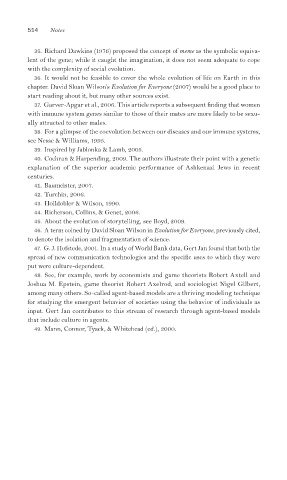Page 549 - Cultures and Organizations
P. 549
514 Notes
35. Richard Dawkins (1976) proposed the concept of meme as the symbolic equiva-
lent of the gene; while it caught the imagination, it does not seem adequate to cope
with the complexity of social evolution.
36. It would not be feasible to cover the whole evolution of life on Earth in this
chapter. David Sloan Wilson’s Evolution for Everyone (2007) would be a good place to
start reading about it, but many other sources exist.
37. Garver-Apgar et al., 2006. This article reports a subsequent finding that women
with immune system genes similar to those of their mates are more likely to be sexu-
ally attracted to other males.
38. For a glimpse of the coevolution between our diseases and our immune systems,
see Nesse & Williams, 1995.
39. Inspired by Jablonka & Lamb, 2005.
40. Cochran & Harpending, 2009. The authors illustrate their point with a genetic
explanation of the superior academic performance of Ashkenazi Jews in recent
centuries.
41. Baumeister, 2007.
42. Turchin, 2006.
43. Holldobler & Wilson, 1990.
44. Richerson, Collins, & Genet, 2006.
45. About the evolution of storytelling, see Boyd, 2009.
46. A term coined by David Sloan Wilson in Evolution for Everyone, previously cited,
to denote the isolation and fragmentation of science.
47. G. J. Hofstede, 2001. In a study of World Bank data, Gert Jan found that both the
spread of new communication technologies and the specific uses to which they were
put were culture-dependent.
48. See, for example, work by economists and game theorists Robert Axtell and
Joshua M. Epstein, game theorist Robert Axelrod, and sociologist Nigel Gilbert,
among many others. So-called agent-based models are a thriving modeling technique
for studying the emergent behavior of societies using the behavior of individuals as
input. Gert Jan contributes to this stream of research through agent-based models
that include culture in agents.
49. Mann, Connor, Tyack, & Whitehead (ed.), 2000.

